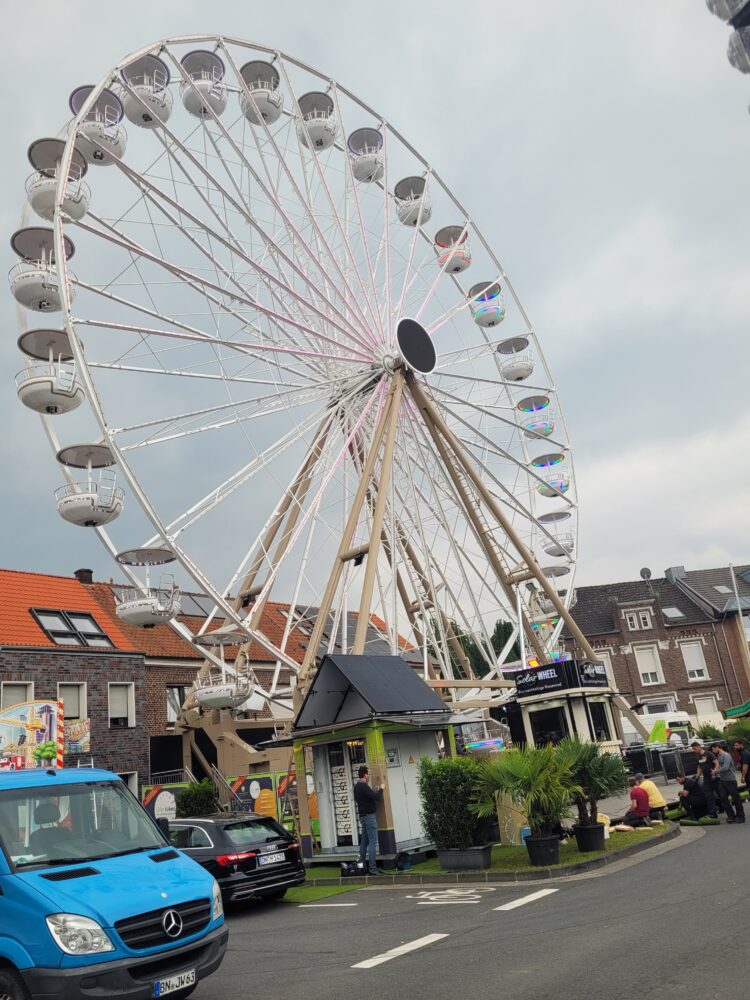
Harvey Wegener is a third generation showman who has taken the traditional ferris wheel and re-invented it for today’s environment – high tech carbon neutral and with a stunning LED light show.
Billed as the first solar-powered Ferris Wheel in the world the Riesenrad Solar Wheel took Harvey Wegener and his wife Emily three years to bring from the drawing board to reality. There were many muscle-aching trial builds along the way, but the result is a sustainably powered, 33 metre high fairground attraction – which you can rent for your event – and which can transported to site and built in less than eight hours.
High energy rides like the ferris wheel are usually associated with the noise and fumes of a diesel generator, and although for safety reasons the equipment has to be connected to a secondary 20kW energy supply for emergency compliance, it’s no longer the case that a diesel generator must be banging away!
With 54kWp of solar panels mounted in every available location, and over 200 kWh of Lithium battery storage the ride can run autonomously late into the night.
Gondolas, waiting area, checkout, railings and back wall are all equipped with solar panels.”For example, we installed 36 panels in the waiting area alone, and 52 on the roofs of the 26 gondolas. We have specially developed panels that are very thin and light for the gondola roofs.” says Harvey Wegener.
Dussmann Industrial Automation GmbH, who are based in Essen, Germany, were responsible for the electrical design, engineering, construction, commissioning and for providing support during the initial production start-up at the fairground in Geldern – using products from German mobile power specialist and product distributor Transwatt.
In the past it has not been possible to take such a powerful ride to locations which don’t have sufficient capacity on the electricity grid. That has changed with battery energy storage: in the North Sea Islands, for example, which can only offer a 16A connection, the grid can supply a steady source of energy for battery storage – including overnight and in the morning when the attraction is closed – and the three-phase inverters will run the wheel from battery storage combined with the limited grid current whenever the attraction is open.
Harvey and Emily Wegener’s new green power supply allows them to take the fun of their road show almost anywhere!
Solar Power Priority
In fact the ride has been achieving greater than 80% sustainability since it began operation in May this year. One of the advantages of the work schedule of a fairground attraction is that the batteries can be charged using solar energy in the morning, when the ride is not yet open and also through the afternoon when visitors begin to arrive …the panels are still able to provide surplus energy to recharge the battery bank in time for a busy evening when it’s dark and the real fun starts!
In operation the attraction has shown itself capable of running mains-free for up to 10 hours in the dark.
What’s in the power container?
- 12 x SmartSolar 150/100 Charge Controllers harvest solar energy from the various panel locations – some will be charging fast, others may be shaded depending upon where they are mounted, of course – yet all solar charging will be synchronised by the daisy-chained charge controllers, maximising the power supply to the lithium battery bank.
- 40 x Pytes E-Box 48100R Lithium batteries store 5.12kWh each – totalling 205 kWh. Victron Energy installations offer a broad range of compatibility with third party devices. More information about the compatibility requirements when choosing Pytes battery storage can be found here. Cross manufacture compatibility allows worry free choices to be made when choosing third party devices for reasons of geography or preference.
- 3 x Quattro 48/15kVA Inverter/Chargers can deliver 45kVA continuously in their configured three-phase 400V operation. The Quattro can accept AC from two charging sources – the grid and a generator, for example – automatically switching to the live source. As mentioned earlier, when the grid can offer only limited power Victron Inverters can easily be configured to limit the power they draw from that source. Whenever demand from the application exceeds that limit, the inverter will supplement grid power with battery power – using the unique PowerAssist feature.
- The devices in the power system talk to each other via a Cerbo GX communication centre. The Cerbo GX also makes system status and programming available to engineers and system users via a GX Touch – a touch screen user interface. Access to data is also made available from anywhere in the world using the Victron Remote Management platform (VRM). All data can be analysed historically and data strands can be selected individually for deep scrutiny – allowing problem solving without visiting site. The Ferris wheel, which might be operated in remote areas, also includes a Starlink router for satellite based internet connection.
- From Rittal there’s a 2000A industrial copper rail and switch cabinets.
- And from Siemens there are Fuses and an Industrial Wireless local area network extending internet coverage to the fairground.
The containerised power for the wheel fills a lorry-loadable unit measuring 2400 x 2400 mm. Not missing an opportunity to harvest more of the sun’s energy – even the container deploys a solar array!
“With lighting and drive, the ride consumes between 150kWh and 180 kWh of energy per day. That varies, depending on how busy the ride is.” says Harvey Wegener.
More thrill-seekers!
The new technology has increased the traffic flow as more customers come to enjoy the ride; to catch the view from 33m altitude – and to experience for themselves what is possible with power from the sun. It is hoped that this example will set a precedent and other fairground attractions will now make the switch to clean, renewable energy – whether bumper cars, chain carousels, rollercoasters, ghost trains or free-fall towers – they could all be operated in a CO2-neutral way.

















 #victronenergy #adventure
#victronenergy #adventure
 ELECTRICS
ELECTRICS 
